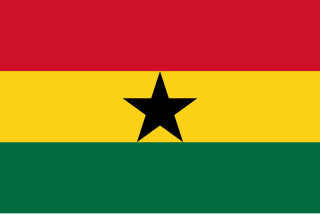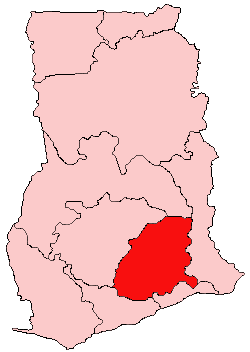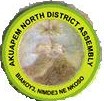Related Research Articles
Yaa Asantewaa I was the Queen Mother of Ejisu in the Ashanti Empire, now part of modern-day Ghana. She was appointed by her brother Nana Akwasi Afrane Okese, the Edwesuhene, or ruler, of Edwesu. In 1900, she led the Ashanti war also known as the War of the Golden Stool, or the Yaa Asantewaa War of Independence, against the British Empire.
Kumasi is a city in the Ashanti Region, and is among the largest metropolitan areas in Ghana. Kumasi is located in a rain forest region near Lake Bosomtwe, and is the commercial, industrial, and cultural capital of the historical Ashanti Empire. Kumasi is approximately 500 kilometres (300 mi) north of the Equator and 200 kilometres (100 mi) north of the Gulf of Guinea. Kumasi is alternatively known as "The Garden City" because of its many species of flowers and plants in the past. It is also called Oseikrom, after Osei Kofi Tutu I.

Ghana is a country of 28.21 million people and many native groups, such as:

The Ashanti Region is located in the southern part of Ghana and it is the third largest of 16 administrative regions, occupying a total land surface of 24,389 km2 (9,417 sq mi) or 10.2 percent of the total land area of Ghana. In terms of population, however, it is the most populated region with a population of 4,780,380 according to the 2011 census, accounting for 19.4% of Ghana's total population. The Ashanti Region is known for its major gold bar and cocoa production. The largest city and regional capital is Kumasi.

Kwahu refers to an area and group of people that live in Ghana and are part of the Twi-speaking Akan group. The area has been dubbed Asaase Aban, or the Natural Fortress, in view of its position as the highest habitable elevation in the country. Kwahu lies in the Eastern Region of Ghana, on the west shore of Lake Volta. The Kwahus share the Eastern Region with their fellow Akans: the Akyem and Akuapem, as well as the Adangbe-Krobos. A significant migrant population from the Northern and Volta Regions and some indigenous Guans from the bordering Oti and Brong East Regions live in the Afram Plains area. They work as traders, farm-hands, fisherfolk, and caretakers in the fertile waterfront 'melting pot'.
Articles related to Ghana include:

The Asante Empire, today commonly called the Ashanti Empire, was an Akan state that lasted from 1701 to 1901, in what is now modern-day Ghana. It expanded from the Ashanti Region to include most of Ghana as well as parts of Ivory Coast and Togo. Due to the empire's military prowess, wealth, architecture, sophisticated hierarchy and culture, the Ashanti Empire has been extensively studied and has more historic records written by European, primarily British, authors than any other indigenous culture of Sub-Saharan Africa.

Akropong is a town in South Ghana and is the capital of the Akuapim North District, a district in the Eastern Region of South Ghana. This town is known for producing snails and palm oil. Akropong has a 2013 settlement population of 13,785 people.

Asase Ya/Afua is the Akan goddess of fertility, love, procreation, peace, truth and the dry and lush earth in Ghana and Ivory Coast. She is also Mother of the Dead known as Mother Earth or Aberewaa.
The Akan people appear to have used a traditional system of timekeeping based on a six-day week. The Gregorian seven-day week is known as nnawɔtwe (eight-days). The combination of these two system resulted in periods of 40 days, known as adaduanan.

The Asante, also known as Ashanti, are part of the Akan ethnic group and are native to the Ashanti Region of modern-day Ghana. Asantes are the last group to emerge out of the various Akan civilisations. Twi is spoken by over nine million Asante people as a first or second language.

The Akwasidae Festival is celebrated by the Ashanti people and chiefs in Ashanti, as well as the Ashanti diaspora. The festival is celebrated on a Sunday, once every six weeks.

Adae Festival is a celebration in Ashanti. Considered a day of rest, it is the most important ancestral custom of the Ashanti people.

The Ashanti Yam Festival is an annual celebration of the Ashanti people of Ashanti. It marks the first harvest of yams during the autumn season, after the monsoon season. The yam is the staple food crop in Ashanti and most of Africa.

Awukudae Festival (meaning: "Wednesday ceremony", is a traditional Ashanti festival in Ashanti. Like the Akwasidae Festival, celebrated on a Sunday, Awukudae is part of the celebrations within the Adae Festival cycle. The festivals of Adae are not interchangeable, having been fixed from ancient times.

Friedrich Augustus Louis Ramseyer also Fritz Ramseyer was a Swiss-born Basel missionary, who was captured by the Asante in 1869 in colonial Ghana, together with his wife Rosa Louise Ramseyer, Basel mission technical staff, Johannes Kühne and French trader, Marie-Joseph Bonnat. Ramseyer was later released in 1874 and pioneered the Christian mission in Kumasi and the rest of Asante. Additionally, he spearheaded the planting of churches in Abetifi. Apart from his evangelism, Ramseyer was instrumental in the expansion of opportunities in the fields of education, artisan industry training, land acquisition for building design and manpower development in the areas he lived and worked in.
Nana Obiri Yeboa was the Kumasehene during his era and the occupant of the Aban Dwa Stool. He reigned from 1660 to 1680. He was succeeded by Nana Osei Tutu as the chief of Kwaman state which was later known as Kumasi state. He was the uncle of Osei Tutu. Nana Obiri Yeboa's uncle was Nana Oti Akenten.
The political organization of the historical Ashanti Empire was characterized by stools which denoted "offices" that were associated with a particular authority. The Golden Stool was the most powerful of all, because it was the office of the King of the Ashanti Empire. Scholars such as Jan Vansina have described the governance of the Ashanti Empire as a federation where state affairs were regulated by a council of elders headed by the king, who was simply primus inter pares.

The Ashanti Empire was governed by an elected monarch with its political power centralised. The entire government was a federation. By the 19th century, the Empire had a total population of 3 million. The Ashanti society was matrilineal as most families were extended and were headed by a male elder who was assisted by a female elder. Asante twi was the most common and official language. At its peak from the 18th–19th centuries, the Empire extended from the Komoé River in the West to the Togo Mountains in the East.
References
- 1 2 3 4 5 WhiteOrange. "Adae Kese Festival". Ghana Tourism Authourity. Archived from the original on 2019-12-26. Retrieved 2019-12-26.
- 1 2 3 WhiteOrange. "Adae Kese Festival". Ghana Tourism Authourity. Archived from the original on 2019-12-26. Retrieved 2020-01-20.
- 1 2 "Adae | Akan festival". Encyclopedia Britannica. Retrieved 2020-01-20.
- 1 2 "Adae Kese Festival". Official web site of Ghana.Travel Corporation. Archived from the original on 27 December 2011. Retrieved 24 November 2012.
- 1 2 "African Festivals: Adae Kese". African. Net. Retrieved 24 November 2012.
- ↑ Roy 2005, p. 42.
- ↑ Agorsah 2010, pp. 42–43.
- 1 2 Roy 2005, p. 2.
- ↑ Asante, Molefi Kete; Mazama, Ama (26 November 2008). Encyclopedias of African Religion. SAGE. pp. 36–. ISBN 978-1-4129-3636-1 . Retrieved 21 November 2012.
- 1 2 3 4 5 6 7 8 9 10 "The Adae Kese Festival". africanpoems.net. Retrieved 2020-01-20.